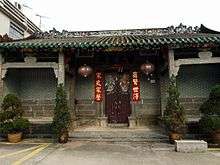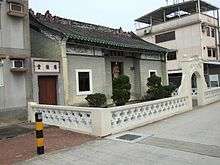Fanling Wai


Fanling Wai (Chinese: 粉嶺圍) is a village in Fanling, North District, Hong Kong, built by the Pang (彭) Clan. It is composed of a walled village and its extensions:[1] Pak Wai (北圍, north wai), Ching Wai or Chung Wai (正圍 or 中圍, central wai) - the walled village, and Nam Wai (南圍, south wai).[2]
History
Fanling Wai is the centre of the Pang Clan who arrived in Hong Kong late in the Song Dynasty.[3] The wai (walled village) was constructed in the Wanli (1572–1620) reign of the Ming Dynasty. Pang Kwei (彭桂) was the founding ancestor of the Pang Clan who went to Lung Shan (龍山), now known as Lung Yeuk Tau of Fanling from Dongguan in 1190. He then moved to Fan Leng Lau in 1220[1] and established a village over there. As the population of the clan increased, they moved westward to settle in Fanling Wai and other places.[4]
Features

Fanling Chung Wai is recognisable with the distinctive pond and layout including features such as cannons and watchtowers. All these elements were crafted to form an integral part of the village setting.[3] The entrance is at the central axis of the walled village with village houses built connected to the walls and seven rows on the left and right of the central axis. Three circular gun holes are on the façade wall of the entrance gate-tower with three painted white circles for feng shui reasons.[4]
The Pang Ancestral Hall (彭氏宗祠), also called Tai Tak Tong (大德堂), is located in Fanling Pak Wai. It was moved to the present site in 1846 due to feng shui reasons. It was rebuilt in 1884.[2]

The Tsz Tak Study Hall (思德書室) in Fanling Nam Wai was built in 1846. It provided education for the village children, with 20 to 30 children being taught there. In 1936, it housed a government subsidized Fanling Public School. Its function as a school ceased in 1957, when a separate school complex was constructed to its north-east. The hall is also used for ancestral worship of the Sze-yan lineage.[5]
Conservation
Fanling Chung Wai is a Grade II historic building.[6] The entrance gate-tower and two corner watchtowers were rebuilt in 1986.[4] The Pang Ancestral Hall is a Grade I historic building[6] since 1981.[2]
References
- 1 2 Chan Kwok Shing: "Negotiating the Transfer Practice of Housing in a Chinese Lineal Village", in Journal of the Royal Asiatic Society Hong Kong Branch, Vol. 37, 1997. pp.63-79
- 1 2 3 Brief Information on Proposed Grade I Items. See #99.
- 1 2 Planning Department - Historical Background
- 1 2 3 Brief Information on Proposed Grade III Items. See #978, 979, 980, 1070.
- ↑ Brief Information on Proposed Grade II Items, pp.549-550
- 1 2 List of Graded Historic Buildings in Hong Kong (as at 6 November 2009)
External links
| Wikimedia Commons has media related to Fanling Wai. |
- Page about Fanling Wai (Chinese)
- Personal page about Fanling Wai (Chinese)
- Pang family of Fanling Wai
- Pang's family website
- Pang's Family (Fanling Wai) Facebook Site
- Kong, Tak-chun, Andy (2000). Cultural landscape architecture Fanling Wai (Walled village) (PDF) (Master of Landscape Architecture thesis). University of Hong Kong.
Coordinates: 22°29′51″N 114°08′07″E / 22.4975°N 114.1353°E